![]()
![]()
![]()
Use LEFT and RIGHT arrow keys to navigate between flashcards;
Use UP and DOWN arrow keys to flip the card;
H to show hint;
A reads text to speech;
30 Cards in this Set
- Front
- Back
|
Classification of Anterior Pituitary Hormones |
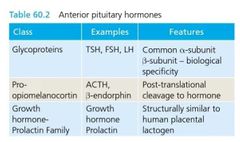
|
|
|
What is the origin & target cell of the trophic hormones released by the hypothalamus |

|
|
|
Regulation of growth hormone release |
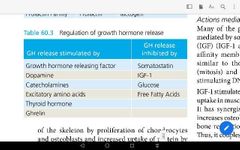
|
|
|
List the releasing factors of Anterior Pituitary Hormones secreted by the hypothalamus. 5. |
1. Thyrotrophin releasing hormone - Tripeptide 2. Gonadotrophin releasing hormone - 10-amino acid peptide LH releasing hormone FSH Releasing hormone 3. Growth Hormone Releasing hormone - 43- amino acid peptide 4. Corticotrophin Releasing Hormone - 41 a mini acid peptide |
|
|
Inhibiting factors/hormones for anterior pituitary |
Dopamine - inhibits prolactin Somatostatin - 14-amino acid peptide. inhibits TSH, ACTH, GH & PRL. also inhibits insulin & glucagon. |
|
|
Where in the hypothalamus do the the hormones secreted by the posterior pituitary gland originate? 2. |
Supra optic and Para ventricular Nucleus of the hypothalamus. The cells of origin are the Magnocellular cells. |
|
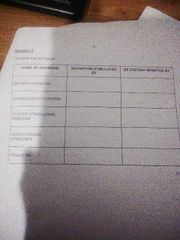
|
. |
|
|
What brings about circadian variations? |
This ‘circadian’ variation is brought about by the interaction of neural, hormonal, nutritional and environmental factors that regulate the basal and stimulated (peak) secretion of hormones |
|
|
What controls circadian rhythms? |
Most circadian rhythms are controlled by an internal biological clock located in the suprachiasmatic nucleus in the hypothalamus. |
|
|
What is a hormone? |
A chemical messenger produced & secreted by a specific endocrine cell, & circulates in trace amounts in the blood & acts in specific target cells (usually remote to the Endocrine gland) |
|
|
Name the three types of hormones & give examples. 6. |
1. Peptides E. G. TRH, GH, LH 2. Amines E. G. Thyroxine, Serotonin & Catecholamines 3. Lipid & phospholipid derived hormones E. G. Aldosterone, Testosterone |
|
|
Three Types of Peptide Hormone & Examples .6. |
1. Short peptide chains eg. TRH, ADH, ACTH & Insulin 2. Longer peptide chains eg. GH(191), PRL(198) 3. Glycoproteins eg. LH, FSH & TSH. |
|
|
Name three Monoamine Hormones and the amine they are derived from? |
Monoamine derivatives; that is, hormones derived from a single amino acid. For example: –Catecholamines are synthesized from phenylalanine or tyrosine. –Serotonin is derived from tryptophan. –Thyroxine is derived from tyrosine. |
|
|
Name the two types of phospholipid & lipid derived hormones and their examples. |
1..-Steroid hormones; for example, aldosterone, testosterone, oestrogen and cortisol 2..–Eicosanoids; for example, prostaglandins, thromboxanes and leukotrienes. |
|
|
Where is the hypothalamus located? |
The hypothalamus is located below the thalamus, making up the ventral part of the diencephalon. |
|
|
Classify the functions of the hypothalamus? .9. |
Regulation of : 1. CVS 2. Temperature 3. Feeding 4. Water balance 5. Defence reactions 6. Sexual function 7. Sleep-wake cyle 8. Behavior 9. Control of Pituitary function |
|
|
Decribe the embryological origins of the different parts of the pituitary gland |
*The anterior lobe- develops from a depression of oral ectoderm in the embryo’s pharynx, known as Rathke’s pouch. *The posterior lobe, or neurohypophysis, develops from a downgrowth of neural ectoderm from the hypothalamus. The posterior lobe never separates from the hypothalamus; the downgrowth persists as the pituitary stalk. *The pars intermedia is a very thin layer of cells located between the anterior and posterior lobes, which also develops from Rathke’s pouch. It is often considered to be part of the anterior lobe and is not well developed in humans. |
|
|
Where is the pituitary gland located? |
sella turcica, a depression in the sphenoid bone at the base of the skull. directly below the hypothalamus, to which it is connected by the pituitary stalk. Covered by the diaphragma sella. |
|
|
General Characteristics of hormones Compare the Peptides & Catecholamines vs Thyroxine & Steroids. |
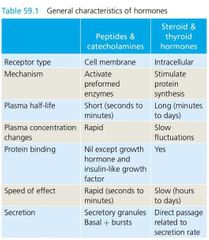
|
|
|
Which receptor bind growth Hormone |
The action of GH begins with its binding to specific cell surface GH receptors belonging to the class 1 cytokine receptor superfamily |
|
|
What is the effect of growth hormone in the cells? |
Binding of GH to its receptor causes a conformational change which allows the receptor to dimerize and the hormone to bind to the second subunit. The conformational change in the receptor allows Janus-associated kinase (JAK) to migrate from the cytoplasm to the receptor and become activated. The activated JAK recruits and phosphorylates downstream transcription (STAT) proteins. GH enhances the transport of amino acids across cell membranes into cells and increases protein synthesis by increasing transcription of DNA in the nucleus to form more RNA and, with enhanced RNA translation in the cytoplasm, increased protein synthesis in ribosomes. |
|
|
Actions of IGF-1 & 2? |
The IGF receptors are high affinity membrane receptors that are tyrosine kinases similar to those of insulin. 1. IGF-1 mediates growth (mitosis) and differentiation. 2. It acts as a mitogen by stimulating DNA, RNA, and protein synthesis. IGF-1 stimulates bone formation, protein synthesis, glucose uptake in muscles, myelin synthesis and neuronal survival. 3. It has synergistic effects with GH in cartilage cells. It increases osteoblastic collagen synthesis. 4. It also stimulates bone resorption by enhancing osteoblastic recruitment. Thus, it couples bone formation and resorption. |
|
|
Structure of growth hormone |
GH is a 191-amino-acid polypeptide with two disulphide bridges it is released in pulsatile bursts by 30%–40% of anterior pituitary cells |
|
|
When does growth hormone peak in the plasma? |
The plasma concentrations of GH show diurnal fluctuations, with a peak occurring 1–2 hours after the onset of slow-wave (deep) sleep |
|
|
What inhibits and stimulates Prolactin? 3 Inhibitors 4 stimulators
|
The secretion of PRL is under tonic INHIBITORY control by the hypothalamus via dopamine (D2), somatostatin and γ-aminobutyric acid
STIMULATED by serotoninergic and opioid pathways, gonadotropin releasing factor and possibly galanin. Inhibition by dopamine is mediated by Gi-protein-mediated inhibition of adenyl cyclase. A potent stimulus for PRL release is suckling, which results in decreased release of dopamine from the median eminence. |
|
|
What type of receptor is the Prolactin Receptor? |
The effects of prolactin are mediated by the prolactin receptor – a class 1 cytokine receptor superfamily resulting in tyrosine phosphorylation of cellular proteins |
|
|
Effects of Prolactin. 4. |
1. Mammary gland growth & development 2. Development of Mammary ducts during pregnancy 3. Milk production (glucose & amino acid uptake, And synthesis of lactose & milk proteins) 4. Suppression of LH secretion (during Lactation) - Amenorrhea |
|
|
Structure of Prolactin |
198 amino-acid polypeptide Synthesized by acidophilus cells of Anterior Pituitary gland. |
|
|
Factors affecting ADH secretion? |

|
|
|
Differences between ADH & Oxytocin |
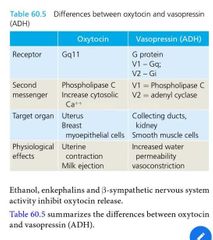
|

